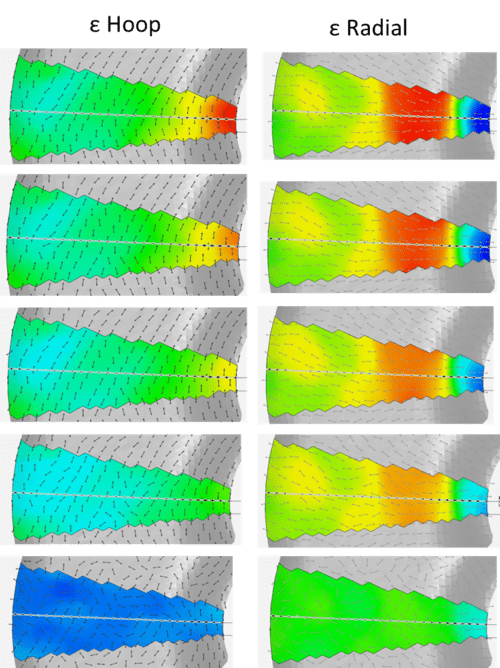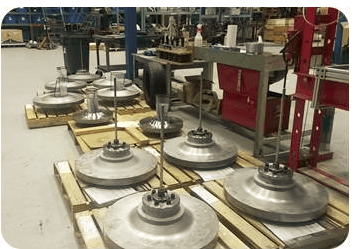Optical Strain Measurement Vs. Traditional Strain Gauging
Leave a CommentIn mechanical engineering, “strain” refers to the degree and the way a structure deforms under a load. An understanding of the strain behavior, combined with the knowledge of the failure mechanisms of structural materials, allows intricate yet robust designs of modern, high-performance aerospace machines, including rocket and jet engines.
High-speed rotors, such as jet engine parts, are subject to very high stress induced by centrifugal force. The need to lighten the parts to enhance the performance of the engine must be balanced with its durability and structural integrity. Engineers must, accurately and confidently, know the stress/strain state of the rotor to make the critical design decisions.
What Is Traditional Strain Measurement?

Further limitation of the strain gauges is that it is a point measurement and is blind to the behavior of the surrounding strain field behaviors. The readings from a gauge placed on a certain position of a test rotor must be interpreted accurately to perform a meaningful comparison against an FEA model.
Optical Strain Measurement Applications in the Aerospace Industry
Test Devices Inc. has been interested in a non-destructive test and manufacturing process – the Rotating Optical Strain System (ROSS) – for some time. The ROSS is a non-contact strain measurement system which eliminates limitations, is less costly and provides more complete data, possibly allowing the measurement at higher temperatures needed for fully understanding the engine parts.
The ROSS will unlock a wealth of new information for material and component designers. The data is valuable for validating (or refining) the numerical models used in designing jet engine parts and gas turbine rotating parts as well as understanding the details of the failure mechanisms limiting the performance of existing parts.
Combined with advanced spin testing capabilities, Test Devices provides a unique testing resource for civil and military jet engine/propulsion system developers. The ROSS can accelerate the development of advanced materials and manufacturing capabilities across the gas turbine industry. It can provide the most relevant data to reduce risks in currently active turbine engine development programs.
Learn More
Optical strain instruments have been on the market for years, commonly used to measure strain in static objects. But in recent years, they’ve been steadily rising in popularity as more and more industry professionals begin to use them to measure strain in high-speed spin tests.
To learn more about how these optical strain gauges can benefit your testing and production processes, reach out to the team at Test Devices today.
Test Devices to Offer In-House Rough Machining Beginning June 2018
Leave a CommentTest Devices Inc. (TDI) is thrilled to announce that we’ll be offering in-house rough machining services starting June 2018.
As a part of our investment in expanding this capability, we’ll be adding two horizontal CNC horizontal lathes (Okuma), allowing TDI to become a convenient one-stop shop. Our team can now serve clients throughout every step of the process, from design to pilot run to full process deployment, all with AS9100/ISO9001 Rev D compliance.
Forging Pre-Spin in Specialty Aviation Applications

The forging pre-spin process may seem easy at first glance, but it’s actually a highly specialized service, and requires a true expert to ensure flawless operation. These professionals must oversee:
- Proper spin tooling design for repeated use
- Commissioning & pilot runs
- Confirmation and monitoring of accurate disk growth amounts
- Troubleshooting for rotor dynamics issues
- Optimizing and troubleshooting quality process-related issues
Reliable Supply for Rising Demand: Preparing for Increased Aircraft and Engine Sales
The demand for aircraft continues to grow, supporting the need for increased air travel. This trend is expected to continue its upward trajectory over the next 15 to 20 years; translating to continued growth in aircraft and engine sales from lead OEMs — as well as an increased need for critical spare parts that require pre-spin and rough machining. Engine turbine disks, for instance, must undergo these processes to ensure optimal performance and safety.
By bringing rough machining in-house, TDI will reduce both costs and turnaround times for our customers, and overall flexibility and responsiveness will be significantly improved. We are well-positioned to meet the rising demand.
New Technology, New Services: Rough Machining From TDI
We aim to serve as a truly dependable, knowledgeable partner, serving every customer’s most challenging mechanical equipment needs.
To learn more about TDI and explore our specialty services and pre-spin testing capabilities, download our free eBook, “Spin Testing for Manufacturing 101,” or reach out to the team today.




